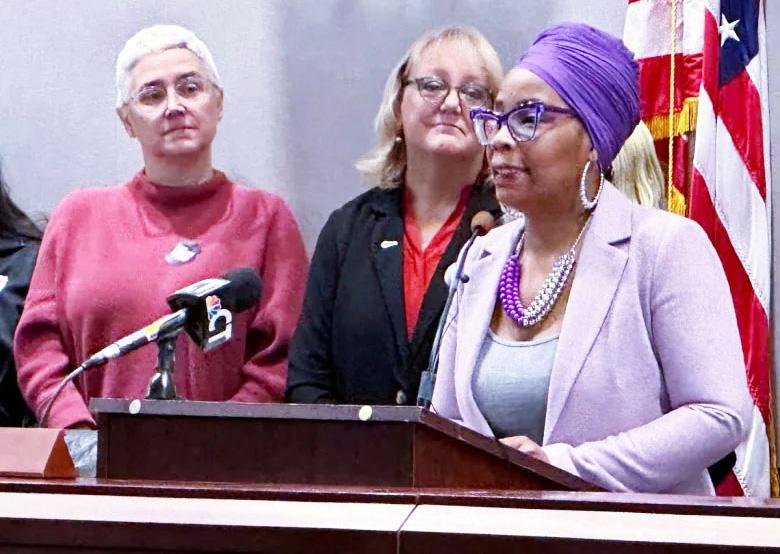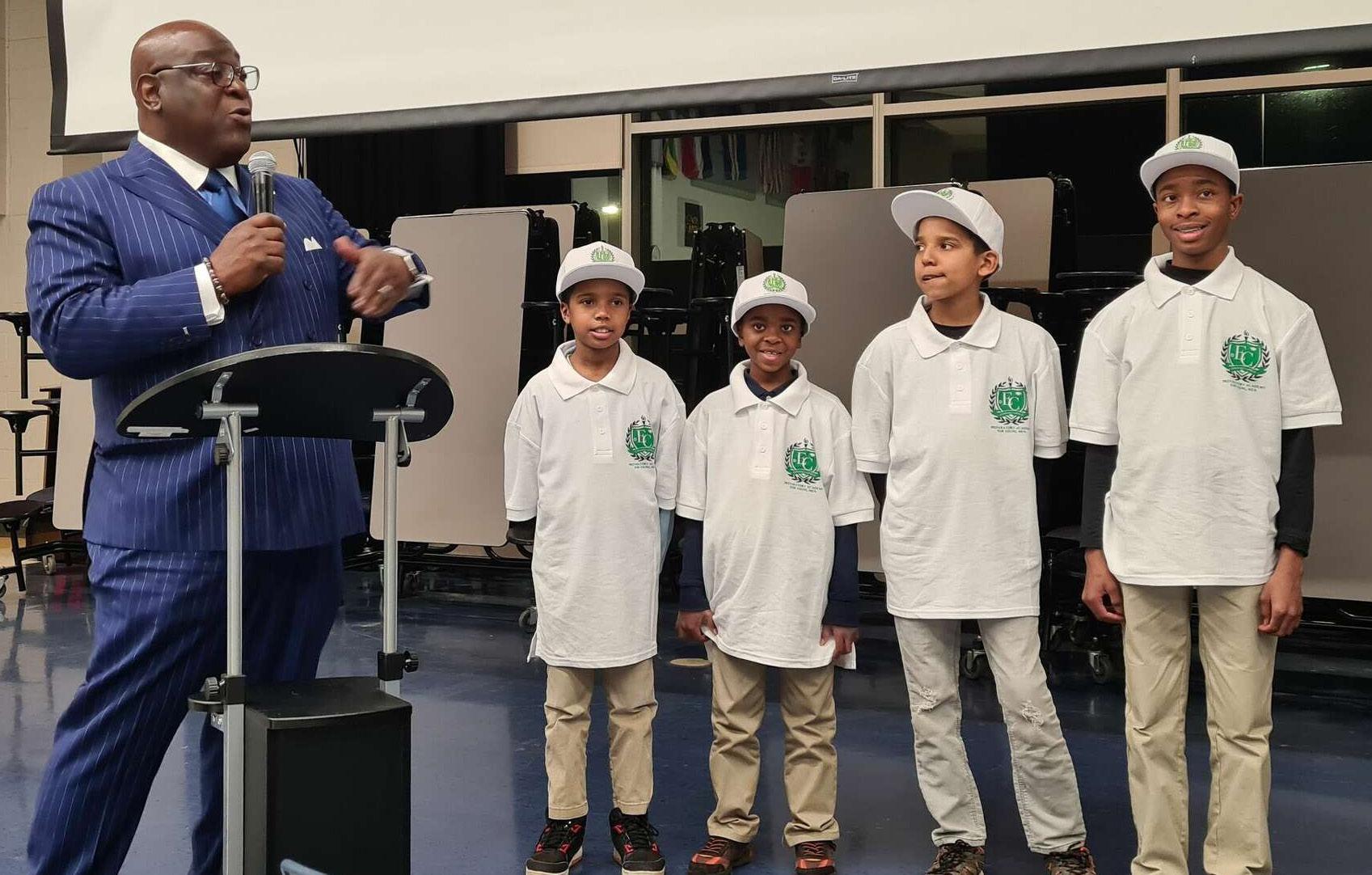




by Viktoria Sundqvist
Attorney General William Tong reached out to Avelo Airlines officials to get some questions answered about its decision to provide chartered deportation flights for the federal government. And he is not happy about the response.
“(Tuesday’s) response from Avelo is totally unacceptable because it contains no response at all,” Attorney General Tong said in a statement this week. “Their overly legalistic and technical letter is insulting and condescending to the people of Connecticut who have invested in and committed millions of dollars to Avelo’s success.”
Budget airline Avelo, which offers flights out of Tweed New Haven and Bradley International airports in Connecticut, recently signed a contract to fly federal deportation flights. The company has said that while it understands this is a “sensitive and complicated topic,” it seeks to provide stability for its 1,100 crew members and keep them employed.
Related story: Avelo Protests Continue at Tweed
In the letter sent to Avelo CEO Andrew Levy on April 8, Tong asked the company to provide a copy of its contract with the Department of Homeland Security and to answer questions about whether it would operate deportation flights out of Connecticut, whether its passengers would be restrained, whether it would transport shackled children or children born on American soil, and whether it would operate flights involving passengers with no valid removal order.
Tong requested a response by April 15, and he got one.
In its response, Levy said Avelo remains committed to public safety and the rule of law, as evidenced by its public, continuous, and persistent compliance with all

federal regulations governing commercial air travel in the United States.
“We do believe from the tone of your letter that there is a fundamental misunderstanding how the federal government contracts the flights that are the subject of your letter,” Levy said in his response.
“The Department of Homeland Security (DHS) creates the scope of work and mandates that the work is performed compliant with Federal Aviation Administration (FAA) regulations…. DHS and FAA unilaterally determine which procedures and practices are used on the flights.”
Avelo’s response directed Tong to submit a Freedom of Information Act request with the DHS for the contract and also directed all questions regarding the contract’s scope of work to the DHS.
“Telling the Office of the Attorney General to pound sand and to ask the Department of Homeland Security for a copy of their contract through FOIA is a callous back-of-the-hand that shows they really don’t care what we think,” Tong said. “It is clear all they intend to do is take state support and make money off other people’s suffering.”
The state and local municipalities have worked to support Avelo’s expansion in Connecticut, including granting an exemption on the aviation fuel tax and upgrading airport infrastructure, Tong said. The state has a right to reconsider whether it should support a business with tax breaks and subsidies if it makes a policy decision that endangers innocent, law-abiding parents, children, and students here in Connecticut,
he said.
Avelo said in its statement that it appreciates the support of the people of Connecticut and takes pride in its new flight routes and the expanded business that Avelo and the people of the state have “created together.”
“We are also proud of our contributions –creating jobs, stimulating economic activity, and providing reliable travel options for residents and visitors,” it said in its response to Tong.
Last week the Judiciary Committee advanced a bill that would limit the type of information disclosed to Immigration and Customs Enforcement officials and would prevent any company that receives any kind of Connecticut tax subsidy from cooperating with the federal immigration
authority.
Republicans on the committee voted against it, saying any attempts to stand in the way of federal officials enforcing federal law is un-American and unconstitutional. Democrats on the committee said treating people as human beings and speaking up when there’s an injustice is the duty of all citizens.
Three Republican Senators also issued a statement this week questioning Connecticut Democrats’ ongoing criticism of Avelo.
“What does it say when Connecticut Democrats are directly adversarial to a major company that creates jobs in our communities?,” asked the statement from Sens. Rob Sampson, Eric Berthel, and Stephen Harding. “Connecticut should be a business friendly state… The least Democrats should do is to not attack a private business for entering into a contract with the federal government.”
Tong, a Democrat and the son of immigrant parents, has been outspoken against President Donald Trump’s current immigration and deportation policies, calling them “cruel and reckless.” This week he also joined a coalition of attorneys general in condemning what they call the Trump administration’s “ideological deportation policy,” targeting noncitizens who speak out against the administration. Tong pointed out that Avelo does not deny that it made a choice to contract with the DHS and potentially transport innocent people, in violation of the law, to maximum security prisons outside of the United States.
“Connecticut has an obligation now to review this business decision and to consider the viability of our choice to support Avelo,” he said. “I strongly encourage Avelo to reconsider its response and its decision to profit from these atrocities.”
by Karla Ciaglo
HARTFORD, CT — The so-called “No Kings Day” rally in support of federal workers drew a crowd to the south lawn of the Connecticut State Capitol Saturday. The event was part of a nationwide protest movement known as “50501.” The decentralized campaign has held previous demonstrations and, according to organizers, more than 700 rallies were planned across all 50 states on Saturday.
While local groups brought a range of priorities — from immigrant justice and climate action to labor rights and economic fairness — some common threads were opposition to recent Trump-era executive orders, the influence of Elon Musk’s cryptocurrency ventures, civil rights rollbacks, climate concerns, and proposals to reduce or eliminate core safety net programs like Medicaid.
Many demonstrators also called on the administration to return Kilmar Abrego Garcia, a Maryland resident whose deportation and due process rights have been the subject of nationwide debate.

The 50501 crowd lined both sides of Capitol Avenue with intermittent chants of “This is what democracy looks like,” “Hands off,” “Bring Kilmar Home” and eventually “Where’s Congress?” — a nod to the absence of lawmakers and elected officials from the event.
Just steps away in Bushnell Park, members of the Local 217 – Unite Here — a union representing hospitality workers — held a simultaneous rally focused on economic justice and labor protections. Union members used the gathering to publicly raise the possibility of a strike.
A banner reading “Workers Beating Billionaires” served as a backdrop for speakers addressing working conditions in the hospitality and healthcare sectors.
Natasha Forrester, a licensed practical nurse, spoke about the challenges facing staff in Connecticut’s nursing homes, emphasizing that the strike discussions go beyond compensation.
“At the end of each shift, we leave not just exhausted—but demoralized,” Forrester said. “This isn’t about saving for vacations or buying something nice. We do
this to pay rent, keep the lights on, and feed our families.”
She called for unemployment insurance for striking workers.
“If we are brave enough to stand up for our residents, the state should stand with us,” she said.
The union crowd later joined the 50501 rally. Capitol police estimated the combined groups at the higher end of 3,000.
The statewide protests also included rallies in New Haven, Middletown, Waterbury and a handful of other communities.
The latest rally, timed to occur on the anniversary of the Revolutionary War battles of Lexington and Concord, was the latest in a series of large-scale protests, including one branded as “Hands Off.”
On April 15, the 50501 Movement posted on Instagram:
“Coming off a historic day where an estimated 5.2 million of you all showed up to join us to declare that We the People reject the Trump/Musk administration’s war on our freedoms and future, the 50501 movement has declared Saturday, April 19th a nationwide day of action!”
by Karla Ciaglo
HARTFORD, CT – Connecticut lawmakers, advocates, and educators gathered for a press conference at the Legislative Office Building on Monday morning to rally behind two major education bills aimed at overhauling how the state funds and regulates special education.
The bills – Senate Bill 1561 and House Bill 7277 – run more than 120 pages combined and propose a statewide tuition rate for private providers, caps on mid-year rate hikes, a new $50 million transportation grant, and a special education offset grant to ease the burden on local districts.
The push comes as costs for private special education placements have surged 35% over the last three years, while the needs of students have also become more complex.
Sen. Sujata Gadkar-Wilcox, D-Trumbull, who co-chairs the legislature’s new Select Committee on Special Education, hosted the press conference and said the bills were crafted after a series of public listening tours and task force meetings. She called the legislation a continued effort to repair a broken system.
“The children of Connecticut have a constitutional right to a quality public education, but unfortunately, the current system leaves many special needs students underserved,” said Gadkar-Wilcox. “This legislation ensures educators and providers have what they need to offer in-district services, while ensuring we act as good stewards of the taxpayer dollar.
The legislation would place oversight and accountability requirements on programs administered by the Connecticut State Department of Education, while also expanding reimbursement for districts to help cover the costs of transportation, program construction, and overall service delivery for special education students.
“Special education in the state of Connecticut is not sustainable, and we need better oversight,” she said. “Right now, we don’t even have the data to understand why costs are rising the way they are.”
One of the goals of the bills is to reduce dependence on costly outplacements and help districts build their own capacity to serve students closer to home. Currently, just 6% of special education students are placed out-ofdistrict, but often at significant cost.
“If I said stop the bleeding, that would be an understatement,” said Shontá Browdy, a member of the Hartford Board of Education. “We’re trying to stop the hemorrhaging of the funds that leave Hartford Public Schools.”
Browdy said Hartford now spends

more than $70 million annually on outplacement tuition, not including transportation.
In New Haven, the price tag is similar.
Rosemary Coffey, a speech-language pathologist, said the district spends around $30 million a year on outplace ment tuition and another $5 million busing students to programs outside the district.
“Private programs can raise their tuition every year without regulation,” Coffey said. “A fixed-rate schedule would support long-term planning and ensure equitable use of public funds.”
The state currently has no cap on what private providers can charge –and no requirement to justify those increases – which forces some districts to divert funds from general education just to keep up. The proposed legisla tion would prohibit mid-year tuition hikes without state approval and dis qualify providers from receiving ad ditional students if they overcharge, while also helping districts build ca pacity through new grant funding to develop in-district programs, improve transportation systems, reimburse for the construction of specialized spaces, and support the recruitment and reten tion of special education staff, from paraprofessionals to certified special ists.
Stephanie Wanzer, a special educa tion teacher from Danbury and mem ber of the state task force, said reten tion is a growing concern.
“We need to retain and grow edu

by Thomas Breen
An all-boys charter school slated to open this fall in rented space in Newhallville still has $2 million in state money available to help it buy a building of its own at a location yet to be determined.
That charter school is called the Edmonds Cofield Preparatory Academy for Young Men.
According to the charter school’s founder and board member, Rev. Boise Kimber, the new school will open its doors to its first cohort of fifth-graders this upcoming August.
The school will launch out of rented second-floor space at 794 Dixwell Ave., an ex-school building that the child mental healthcare provider Clifford Beers purchased in March 2024 from the APT Foundation.
Kimber and John Taylor, the CEO of the charter school management company Elevate Charter Schools, said that Edmonds Cofield is currently seeking parents of rising fifth-graders interested in applying to be in this first class. They’re looking to launch with 75 students.
“We’re about a third of the way to that,” Taylor said about enrollment.
Taylor said the school hosts an open house every Wednesday at 6 p.m. at 794 Dixwell, where parents and guardians “can hear about the value-add of a single-gender education.”
“They’re going to hear that it does matter for boys to be in an environment where the program both academically and socially-emotionally is geared 100 percent towards young men,” Taylor said.
Kimber first won permission from the state Board of Education back in March 2023 for an initial certification for the planned new charter school, which is named after two late New Haven Black community leaders, the Revs. Edwin Edmonds and Curtis Cofield.
In December 2023, the state awarded Edmonds Cofield a $2 million grant to support the charter school’s “acquisition and renovation costs.” At the time, Kimber told the Independent the school planned to use that state money to purchase 311 Valley St., the site of the former West Rock STREAM Academy public school building.
Nearly a year and a half later, what’s the latest? Has Edmonds Cofield spent any of that $2 million state grant? Are they still looking to buy 311 Valley?
Matthew Cerrone, a spokesperson for the state Department of Education, said that this $2 million grant is still with the state Office of Policy and



Management (OPM) since it hasn’t been requested yet by the state’s education department. “We request for an allotment when the project is in the works, and this hasn’t moved forward yet,” he said.
Chris Collibee, a spokesperson for OPM, said that there is no time limit on the allocated funds.
That means Kimber’s school will continue to have access to this $2 million in state funds for as long as the school is around.
Per the state bond commission’s original December 2023 approval,
plans for its properties.
“We haven’t yet made a decision about school properties that may become ‘surplus’ in the context of a facilities master plan,” NHPS spokesperson Justin Harmon told the Independent when asked if the district plans to sell 311 Valley to Kimber’s charter school.
“Any surplus facilities will revert to the city, and they will decide how to repurpose them.”
When will the district know exactly which properties it deems “surplus”?
“One of the purposes of the facilities audit we are undertaking is to inform decisions about further mergers and about the facilities footprint that we should work to maintain over the longterm,” Harmon said. “As I understand it, that study will also give us a rationale for declaring certain buildings to be surplus. The study should be in hand in the next few months.”
In the meantime, Edmonds Cofield Academy is gearing up to open its doors in rented space at 794 Dixwell this fall as it continues to look for a property to purchase.
Clifford Beers Executive Director Ilaria Filippi confirmed for the Independent that her organization has a two-year lease with Edmonds Cofield Academy that began last June. The charter school had initially planned on moving in this current school year; Kimber said the school pushed back its start date by a year as it works to recruit new students.
Filippi said that 794 Dixwell’s second floor is all ready for the charter school to move in, now that Clifford Beers has completed repairs to the building’s roof with the help of $300,000 in city funds approved by the Board of Alders. She said her organization completed those repairs a year ago.

John P. Thomas Publisher / CEO
Babz Rawls Ivy Editor-in-Chief Liaison, Corporate Affairs Babz@penfieldcomm.com
the charter school must use these funds for “acquisition and renovation costs.” They cannot be used for rent, and they have to be used in the City of New Haven, though they are not tied to any one particular address such as 311 Valley.
Asked if the charter school still hopes to buy 311 Valley, Kimber said that the school’s management company is “looking around for a building.” They haven’t found one yet. They might wind up buying a different former public school building, depending on New Haven Public Schools’ (NHPS)
As for the rest of the building, Filippi said that Clifford Beers plans to open on July 1 two “school readiness” programs on the building’s first floor. Those two classrooms are already outfitted, and will have a total of 38 students between the ages of 3 and 5 years old. Clifford Beers has applied for the relevant licenses from the state Office of Early Childhood Development for those programs, and is on track to open them this summer.
Filippi also said that Clifford Beers plans to apply again for state Community Investment Fund (CIF) dollars to help fix up the rest of 794 Dixwell.
“The building has been vacant for a very long time,” she said. “Our intention is to create a mixed-use building for programming and other community activities” at that site. “It needs to be brought up to code,” thus the organization’s application for state financial help.
Advertising/Sales Team
Keith Jackson Delores Alleyne
John Thomas, III Editorial Team
Staff Writers
Christian Lewis/Current Affairs
Anthony Scott/Sports Arlene Davis-Rudd/Politics
David Asbery / Tanisha Asbery
Jerry Craft / Cartoons / Barbara Fair Dr. Tamiko Jackson-McArthur
Michelle Turner / Smita Shrestha William Spivey / Kam Williams Rev. Samuel T. Ross-Lee
Contributors At-Large
Christine Stuart
www.CTNewsJunkie.com Paul Bass www.newhavenindependent.org
Memberships
National Association of Black Journalist
National Newspapers Publishers Association
Greater New Haven Chamber of Commerce
Greater New Haven Business & Professional Greater New England Minority Supplier Development Council, Inc.
The Inner-City Newspaper is published weekly by Penfield Communications, Inc. from offices located at 50 Fitch Street, 2nd Floor, New Haven, CT 06515. 203-3870354 phone; 203-387-2684 fax. Subscriptions:$260 per year (does not include sales tax for the in State subscriptions). Send name, address, zip code with payment. Postmaster, send address changes to 50 Fitch Street, New Haven, CT 06515. Display ad deadline Friday prior to insertion date at 5:00pm Advertisers are responsible for checking ads for error in publication. Penfield Communications, Inc d.b.a., “The Inner-City Newspaper” , shall not be liable for failure to publish an ad or for typographical errors or errors in publication, except to the extent of the cost of the space in which actual error appeared in the first insertion. The Publisher reserves the right to refuse advertising for any reason and to alter advertising copy or graphics deemed unacceptable for publication. The entire contents of The Inner-City Newspaper are copyright 2012, Penfield Communications, Inc. and no portion may be reproduced by any means without the written permission of the publisher. 10
By Jasmine Marshall
Jasmine Marshall is a first-year MBA student at the Yale School of Management and a Board Fellow with the Ely Center of Contemporary Art (ECOCA). She submitted the following as a citizen contribution.
In the glass-lined hallways of the Yale School of Management (SOM), a new presence now holds space—an examination of commerce and the complex history of New Haven. On a recent Thursday, the unveiling of Black Governors, a new painting by Detroit-based artist Mario Moore, transformed the typically corporate setting into a site of cultural and communal memory. Light filtered through the windows as guests gathered, drawn in by Moore’s layered depiction of “Black agency” through time, resistance, and labor.
“Black agency is about the history of this country, drawing attention to historical moments,” Moore said during his artist talk. He also referenced “post-traumatic slave syndrome,” a term coined by Dr. Joy DeGruy, calling attention to the linear trauma Black people have endured in America that still impacts us today. Through his work, Moore sheds light on the often overlooked, albeit available, nuggets of history that highlight this phenomenon, driving viewers to pause and reflect.
Moore’s painting was commissioned by Yale SOM following a yearlong collaboration between the artist and the university, supported by The Artsy Fund, which was established through the generosity of an anonymous donor. Drawing from New Haven’s history of slavery and commerce, Black Governors is both a site-specific reflection and a national commentary. In richly textured oil, Moore highlights Black leaders from the 18th and 19th centuries, focusing on innovators in New Haven such as William Lanson, Bias Stanley, and Margaret Stanley.
The remarkable contributions of these entrepreneurs—Long Wharf, neighborhoods, churches—have shaped the New Haven community in many ways.
The result is a visual archive of Black life and leadership: Yale custodians

("Sweeps") are featured alongside references to one of the earliest known images of an enslaved Black woman in America, from the late 1700s. At first glance, the painting captivates with its detail and precision. But with closer examination, its layers begin to reveal themselves, uncovering histories and narratives that reflect Moore’s commitment to “telling multiple stories within one framework.”
A Portrait of Process
Moore’s process is as much about human connection as it is about visual sto-
rytelling. Before his brush ever touches the canvas, he moves through communities, sketchbook in hand, engaging with people whose stories he hopes to portray.
During his time in a residency program at Princeton University, for instance, he struck up a conversation with Jalen, a local man who worked outside of the university. What began as a casual chat became the start of a portrait partnership.
“It’s not about making a great drawing,” Moore said. “I’m interested in learning what representation means to them and
then working together on the painting.”
This ethos of mutual recognition carries through his practice. When painting figures like Jalen, Moore often produces etchings or prints that he gifts to the subjects. His upcoming contribution to the Ely Center of Contemporary Art's 10th Anniversary Benefit Gala, for instance, is an etching of Jalen, based on the original painting Moore created during his time at Princeton.
“Printmaking started for me when I
studied abroad in Italy in undergrad,” Moore said, reflecting on his interest in exploring different mediums.
The artist’s own history—growing up in Detroit with a painter mother, attending Malcolm X Academy, and taking an early apprenticeship with an oil painter—grounds his work in both discipline and defiance. His practice resists erasure, asserting Black presence in spaces where it has historically been denied.
Moore recalled a recent episode where a museum board member resigned in protest over a proposed acquisition of his work. The museum acquired the piece anyway, a testament not only to Moore’s artistic talent but also to the role of art in challenging institutional norms and sparking critical dialogue.
Rather than striving for hyperrealism, Moore focuses on texture and luminosity, qualities that reveal themselves as you zoom into his pieces. “I want you to feel like you can enter into the piece,” he said. In Black Governors, this philosophy becomes visceral. The painting invites the viewer not just to look, but to witness: to consider the legacies of racialized labor, the role of institutions like Yale in shaping those legacies, and the possibilities for reimagining who belongs in spaces of power.
Attendees at the opening ranged from SOM faculty and students to members of New Haven’s broader arts community. Several lingered near the painting after the talk ended, taking in the details and seizing the opportunity to chat with Moore.
As Moore continues to explore themes of representation, labor, and resistance, his presence in New Haven will live on—not only through Black Governors, but through the etching of Jalen that will soon make its way into another community setting. And for those who walk the halls of Yale SOM in the years to come, Black Governors will remain as a quietly powerful, ever-present, and uncompromising call to remember, reflect, and consider what could be.



Lucy Gellman, Editor The Arts Paper newhavenarts.org
At the front of Ben Scudder's history classroom, the year was 1898, and the United States and Puerto Rico were at a standstill. Puerto Rico, played by junior Japhet Gonzalez, wasn't thrilled about the U.S. invading the island, which had already withstood centuries of Spanish colonial rule. The U.S., played by junior Jonaily Colón, insisted that it would be an auspicious new start. Behind them, a giant map of the world covered the wall, rainbow-patterned continents jutting into an expanse of blue.
"Um, ok—are you gonna make us a state, then?" Gonzalez asked. Colón's mouth twisted uncomfortably; the U.S. hadn't expected this question.
"Mmmm, fun-ny," she said, sucking the air in between her teeth. "We haven't even considered that. Well, at least, not yet."
It's one of the ways students at High School in the Community (HSC) are bringing history to life in Scudder's section of "Black & Latinx/Puerto Rican Studies," a year-long elective that is now in its fourth year at the school. As it sprints from creation of race and racism to the Mexican-American War to protest culture across the arts, it is teaching students a history that is still often lost to dominant narrative.
In so doing, it’s also changing how they understand themselves, their city, and their country within the curriculum.
“I’ve never taken a class like this before,” said senior Sau'mora Short, who is one of the class’s most vocal participants. “I feel like in each history class, you learn something you never knew.” After years of learning about the same few Black Americans—usually in February—she was excited for an elective that offered a broader lens on history.
The class, multiple iterations of which Scudder has taught, grew out of years of statewide, youth-led advocacy, including from New Haven-based groups like Students for Educational Justice and Metropolitan Business Academy’s Nataliya Braginsky. In December 2020, the Connecticut State Board of Education approved the class as a high school elective, requiring that all Connecticut public high schools be ready to teach it by fall 2022. At HSC, Scudder splits it in half, focusing heavily on Black history in the United States before making the pivot to Puerto Rico and cross-cultural solidarity movements in late March. Because “the state curriculum is a beast”—even cleaved into two semesters, it covers enough history to be a two-year course—Scudder approaches it “more like a playbook,” working through what he can while making sure that students are still learning.
He also tries to make it as interactive as possible, weaving in elements of New Haven history where he can. Earlier this year, for instance, the class attended Shining Light on Truth: New Haven, Yale, and Slavery at the New Haven Museum, learning about the city’s history of slavery and the HBCU that wasn’t all before

the end of class.
On a recent morning, he took students to Wooster Square, to see the new statue that stands where a monument to Christopher Columbus came down in 2020 (“we don’t like it,” Colón said emphatically). Even a class on Puerto Rico, environmental racism and U.S. aid can feel close to home: many of his students have family members who were directly affected by Hurricane Maria. So far, nothing about his teaching has changed with the current administration.
“We haven’t had organized conversations” about recent attacks on the Department of Education and how they might affect curriculum going forward, he said. “But if this curriculum is under attack, then HSC is under attack.”
Students, meanwhile, come to the course for some version of the same reason: they’re fed up with what they’re getting (or more aptly, not getting) in their other history classes, and want to know more about who has been written out of the history. Gonzalez, for instance, knows bits and pieces of Puerto Rico through his family, members of which hail from the historic port city of Loíza.
What he craves, though, is a fuller picture of the place that his family calls home, both before and well after sixteenth-century colonization. He likes to dance, for instance, but has never formally learned about or had a chance to try la Bomba y la Plena. He visited the island once during childhood, but hasn’t been back since. When he’s able to look at a timeline or debate Puerto Rican statehood, it feels like a puzzle piece sliding into place.
Or Colón, who serves as a student representative on the New Haven Board of Education and identifies as both Puerto
Rican and Dominican. Before this year, “I knew a little bit” of Puerto Rican history, but felt largely in the dark, she said. Her family speaks Spanish at home; her mom connects her to her roots through dishes that always seem to be going on the stove. But she’s never made it to the island, which she hopes to visit one day. While her paternal grandmother is still in Ponce, she comes to the family in New Haven, instead of the family coming to her. “Taking this class has helped me learn more about my own history,” said Colón as she shaded in parts of a timeline that began in 1493, with Columbus’ second voyage. Part of the learning happens in between worksheets and planned discussions, as students interrogate the materials—and work with each other—to better understand history. As Colón finished her timeline and rattled off her mom’s lexicon of dishes—yucca, plantains, arroz con grandules y pernil, pasteles—Gonzalez made murmurs of approval from across a cluster of desks (“You eat that too? Get out!” he said of rellenos de papa, a smile at the edges of his mouth).
They were interrupted as Scudder brought the class back to attention, lo-fi music still playing in the background. He looked from students back down to a worksheet he had handed out just minutes before. “You guys, look at this,” he said. He motioned to Short, who had been working quietly at a desk on the right side of the room for almost an hour. “Sau'mora pointed out this glaring omission.”
At her desk, Short read from the sheet, which introduced Puerto Rico as a land that belonged to the Indigenous Taíno people for generations, until the arrival of Juan Ponce de León in 1508. There was the sentence that had snagged her attention: In the next century, the Indigenous people were ravaged by disease.
Her face hardened a little. That one
up a whiteboard with a breakdown of votes for Puerto Rican statehood a century later in 1998. “We’re 100 years later now. This is the third vote that Puerto Rico has had over 100 years about their status.”
During the 1998 vote, Scudder explained, 2.5 percent of people voted for Puerto Rico to become independent, which means that it would have status as its own country. Forty-six percent voted for statehood; 50 percent voted “none of the above,” in what pro-statehood advocates decried as close to heresy. Scudder pushed the clock forward again, to a fourth vote in 2012.
“We’re gonna vote again,” Gonzalez said with an aw shucks sort of smile. “I know, I know, but we’re shaking things up. We’re gonna ask two questions. First: do you want the current status to change? And second: What would you want the change to be?”
choice—the use of the passive voice— she’d seen it in history books so many times before. It took all of the blame off the European colonizers who devastated the Taíno population, from forced marriage and forced labor to the spread of diseases that the island had never seen before.
“I feel like they try to not put the blame on them,” she said. “It happens a lot. Nobody really knows that Taínos was there first,” because that’s still not how it’s taught in the mainstream.
“Right?” Scudder said, praising Short for the catch. “When you look at who is responsible, talking about Columbus and his men and the King and Queen of Spain, [they] did some pretty awful stuff. And this just completely skips over that.”
“It’s so crazy,” Short said.
“And Scene!”
Moments later, that vision for an engaged class came to life anew, as Gonzalez and Colón took their places at the front of the classroom and prepared to perform a skit about Puerto Rican statehood for the first time. Above their heads, a neat row of blue-and-red posters peeked out, as if the figures on their surfaces were looking on. A white question scrolled across a monitor between them: Why do you think the U.S. did not accept the result of Puerto Rico’s 2012 vote for statehood?
Winding the clock back to summer 1898, the two role-played the U.S. invasion of Puerto Rico, which took place during the Spanish-American War. Gonzalez, sporting a constellation of ribbons the same light blue of the nineteenth-century Puerto Rican pro-independence movement, wasn’t having it. He wanted statehood or bust.
“All right, fast forward, and scene!” Scudder said, stepping in and holding
“Mmmm, I dunno, Puerto Rico,” Colón said. Few members of the class knew it then, but the uncertainty in her voice was actually something that sounded a little like empire, of not wanting to let go. Scudder, shuffling back to the front of the room, held up another whiteboard.
This time, he explained, 54 percent of people—a clear majority—voted against keeping Puerto Rico as an unincorporated territory of the United States, through which its citizens are recognized as Americans, but do not have voting rights. In addition, an overwhelming 61 percent of people voted that statehood should be the island's new status.
“But, there's a catch,” Scudder said. “Remember, what was the catch?” he looked up at the class.
“Twenty-seven percent didn’t vote,” Short ventured, a vocal question mark at the end of her sentence, where the inflection tipped upwards.
“It wasn’t necessarily didn’t vote,” Scudder said. He explained that following the vote, 27 percent of ballots—for any number of reasons that weren’t ever made clear—were considered invalid or left blank. That is—considered invalid by the U.S. government. That pesky use of the passive voice had crept back into the discussion. Which means Gonzalez was about to get his heart broken.
“We did it! We finally did it!” he exclaimed. “There’s a majority against the commonwealth! There’s a majority for statehood!”
“Woah, woah, woah, Puerto Rico,” Colón countered. “I’m looking over these results, and I gotta tell you, they look pretty convoluted and confusing to me. Two questions: Who does that, and what does it all mean?”
Members of the class were paying close attention now. Gonzalez looked befuddled, then upset, then injured. He moved forward through his lines, “It’s starting to feel like you’re not taking the will of our people very seriously,” he said. Colón Con’t on page 07
mock gasped.
“How dare you!” she spit out, trying to hold back a smile (“Bruh, what is this corny-ass play?” she had asked Scudder before the performance, looking over the script). The class burst into applause.
Short, who had been watching and listening carefully, said that it made sense to her that the U.S. wouldn’t allow statehood. In fact, that seemed exactly like something the U.S. would do.
“It’s probably because they [the U.S. government] don’t want Puerto Rico to have statehood,” she said. “So they’re trying to find any reason not to take their results.”
Civics Outside Of the Classroom
Outside on Union Street, class continued even after the period was over, as a few students joined artists Johan Zongo and Katelyn Wong of Bright Spaces, a Yale student group dedicated to both public art and public service, to work on a mural. After meeting Scudder at a New Haven Climate Movement protest, Wong and Zongo worked with HSC students in the class to design a mural for a section of wall that runs along the side of the school.
“Our goal is to literally brighten up spaces,” Zongo said, grabbing a few bottles of paint, brushes and water from where he had stored them in Scudder’s first-floor classroom. With student input, he and Wong came up with a design that included portraits of Shirley Chisholm, Sylvia Mendez, and Thurgood Marshall, as well as the school’s signature eagle, soaring above the figures in an archway.
As they painted Friday, both recalled turning to the visual arts as an outlet— Wong in San Diego and Zongo in Ghana and Burkina Faso—long before they landed at Yale. After arriving in New Haven for college, the arts were a door to New Haven. The two have brightened up Noir Vintage, learned their way around city nonprofits, and in Wong’s case worked with youth at ConnCAT during their summer program.
As she welcomed students, Wong zeroed in on an image of desks—part of the mural is a classroom—that she and Zongo had traced the week before. “Let’s start on those,” she said.
Soon, students were painting, sharing a trio of brushes to give everyone a chance.
Junior Justin Welch, who thought the opportunity might be fun, found himself totally immersed in the process.
“Painting is a form of relieving stress,” he said.
Junior Diana Robles, who had come to see what the hype was about, craned her neck until she could see a yellow halo around Chisholm’s face. Growing up in New Haven, “I’m really interested in how everything came to be,” she said. “It feels like a lot of this is going backward but I feel like we need to highlight the people who got us to where we are today.”
She thinks about that in her law classes—a hallmark of HSC—she added. Recently, students studied the decisions in Brown V. Board of Education and Tinker V Des Moines.
“Just one case can change so many things,” she said.

Connecticut’s Beardsley Zoo turns up the heat for this year’s Wild Wine, Beer & Food Safari on Saturday June 7th, with a next-level, local celebrity twist.
Connecticut’s Beardsley Zoo is thrilled to announce that Chef Cathy Cann, the culinary queen behind Cat’s Kitchen of Connecticut, will be featured during VIP Hour at this year’s must-attend fundraising event! Cathy Cann was recently a participant on FOX’s hit show "Next Level Chef" with Gordon Ramsay, where her bold flavors and creative cooking took the stage.
Guests at the VIP Hour on Saturday, June 7th will get a chance to taste Cat’s creations in person—before the gates open. With early entry, special animal encounters, and exclusive pours from Foolproof Brewing, Sound Coffee and Bites Company, this experience is nothing short of unforgettable. Tickets for VIP hour are limited and almost sold out, click here for your ticketshttps://www.beardsleyzoo. org/wild-wine.html.
Chef Cathy Cann’s involvement is a preview of the caliber of offerings attendees will find throughout the entire event. The Wild Wine, Beer & Food Safari is a full-flavored expedition through a vibrant scene with over 40 incredible foods, beer, and wine vendors, each offering tastes as exciting and diverse as the animals on exhibit.
Wild Wine, Beer & Food Safari features fare from local restaurants and caterers such as: Amrita Health Foods, The Batch Pantry, Colossal Kielbasa, Shake Shack, East Coast Clambakes, Dave Grant Caterers, Fortuna’s, Garden Catering, Lesser Evil, Little Pub, Nuovo Pasta, Palmer’s Catering & Events, Retreat Sweets, Rose Sisters Chips, Taco Loco, The Taste Garden, Vazzy’s, and Vinny’s Pizza.
Guests will also enjoy live music, fun games, a premium silent auction, and encounters with amazing zoo animals. Don’t miss your chance to eat, drink, and go wild for a great cause! Click here for tickets and more details https://www.

beardsleyzoo.org/wild-wine.html.
As one of the Zoo's largest fundraisers, Wild Wine, Beer and Food Safari supports the care of endangered species, exhibit expansions, and educational programming. This is an adult only 21+ event, rain or shine. For tickets visit https://www. beardsleyzoo.org/wild-wine.html.
Thank you to all sponsors who make this event possible: Generous Guinea Hog Sponsors M&T Bank. Grand Gator Sponsor Liberty Bank. Big Hearted Bear Sponsors Aquarion, Ring’s End, Coca-Cola Northeast, Baileys and Casamigos. Opulent Otter Sponsors: Industrial Health & Safety Consultants, LLC and Shoprite. Kind Condor Sponsor: Robinson & Cole LLP.
To volunteer, sponsor, purchase tickets, or more about the silent auction please visit the website athttps://www.beardsleyzoo.org/wild-wine.html. Stay updated by following us on Facebook and Instagramfor the latest news and announcements.
By Lucy Gellman
The little boy—later, we’ll learn that his name is Franklin—pedals forward on his bike, eyes fixed on the horizon. He is focused, determined; his mouth hangs open, as if he’s about to shout something into the air. His hands, fingers gently rounded, grip the handlebars. On his back, a green bookbag sits snugly across his shoulders, whole universes stuffed inside.
Welcome to the illustrated version of The Mind of a Saint, a collaboration between artist Raheem Nelson and the lyricist, writer and musician Skyzoo inspired by the eponymously named album and series that inspired it. Based on decades of Black history—and John Singleton’s FX series, Snowfall—Nelson has released a limited run of the book, selling hundreds of copies to a dedicated fan base.
This week, he’ll be presenting it at the Trinity International Hip Hop Festival, a program of Trinity College in Hartford. In a time of increasing uncertainty, he’s counting it as a personal win.
“This has opened a lot of doors already,,” he said in a recent interview at the Ives Main Branch of the New Haven Free Public Library. “I’ve gone from fan to friend to collaborator. It’s a dream project, honestly.”
The idea for the collaboration was born a year ago, after Nelson found himself particularly moved by Skyzoo’s The Mind of a Saint. The album, which came out in January 2023, presents 10 tracks from the perspective of Franklin Saint, the character at the center of Singleton’s Snowfall. In the series, Saint is a young Black kid growing up in 1980s-era Los Angeles, the son to a real estate agent and former Black Panther with whom he is estranged.

Through a series of events—call them decisions, call them systemic failures, call them America’s war on Black men— Franklin becomes involved in selling drugs, using it to build wealth when other sources of labor and income consistently come up short. Around him, America is veering toward the height of the crack epidemic, particularly pronounced in dense, populous and segregated cities like Los Angeles.
When the series came out, Skyzoo— who grew up in Brooklyn’s Crown
Heights neighborhood in the 1980s and 1990s—found that it reminded him of a system that had failed generations of Black men and Black families, in a chapter of recent history that felt distinctly, cruelly American.
“The idea of ‘The Mind of a Saint’ was inspired by growing up in the late 80’s and early through mid 90’s as a child growing up in NYC and seeing the effects of what I, amongst others, feel was a premeditated and predetermined plan to wreak havoc on communities of color, communities of
people who look like myself,” he wrote in a forward to the book. “Communities like the ones I was born and raised in.”
The album blends snippets of the show and tight, often poetic lyrics and audio. In “Panthers and Power,” for instance, Skyzoo samples a tinny, archival recording introducing the Black Panthers’ 10-point program, launched by Bobby Seale and Huey Newton in the 1960s. Later in the album, the artist has moved on to the fifth season, and opens with a clip from an episode about the devastation and isolation that comes, inevitably and frequently, from participating in violence— sometimes because the system is already rigged against you—that guts the same communities that raised you.
The first time he heard the album (which, of course, turned him on to the show), Nelson was equally moved. He kept listening, finding new things to appreciate each time he pressed play and traveled through the 10 tracks. A lifelong music lover and self-described grown up “geeky kid,” he’d already been following Skyzoo for about a decade, all the way back to his “Barrel Brothers” and “Music for My Friends” days.
What hooked him, in part, was how cinematic the album felt, as though he could see the scenes playing out in the threeto five-minute chunks that comprised each song. In Snowfall, Franklin Saint is named after Peanuts’ first Black character, himself also a creation of 20th-century Los Angeles history. Nelson, who has been drawing comics for as long as he can remember, couldn’t stop thinking about what an illustrated version might look like. He ultimately decided to reach out to the musician, and leave the rest up to fate. He was thrilled, if also surprised, when Skyzoo responded.
“I went to bed one night and it kind of hit me,” Nelson remembered. “I wanted
to do an art series based on every track of the album—to add something to the music and the show. We would have conversations about what the art would look like—there was a lot to pull from. Each song portrays just a segment of the show.” Now, it lives out in the world, chronicling—not without a critical eye—the same time period that both Singleton and Skyzoo dive into with their work. From Nelson, a viewer can see Franklin’s descent from convenience store clerk into a young guy caught in the midst of a drug epidemic that is so much bigger than him, struggling to step back without losing everything he has.
On one page, he and colleagues roll giant, snowball-colored boulders up a hill, his head tilted down as a supervisor—call him a kingpin, or maybe an overseer— looks on from above, a foam cup perched in his hand. There’s something deeply Sisyphean here, undercut with the fact that it’s a cartoon character bringing the scene to life.
In another, Franklin is hunched in his kitchen, in front of a pink platform that reads “Mother Knows Best.” Behind it, his mom, Cissy, listens with her head tilted to one side, a concerned look on her face. Behind her, an electric mixer sits untouched on the counter; the buds of a tree and smear of sky appear through a window. The image works on multiple levels, a direct quotation of Schultz’ comic strip, in which Lucy sets up a lemonade stand and offers five-cent psychiatric consults to Charlie Brown.
What Nelson nails, in this Schultzification of Franklin and of those around him (the characters, all done in a Peanuts-esque style, are figures from the FX series), is a balance between the fleeting, delicate and precarious nature of youth and the devastating realities of a drug epidemic in Con’t on page 11















by Laura Glesby
As the final beam of ConnCAT’s future health-job-childcare hub rose on Dixwell Avenue, Kim Harris and Julia Ficklin each thought of generations past and generations to come.
For Ficklin, that beam meant a longtime dream of her late husband, Alder Tom Ficklin, clicking into place.
For Harris, it meant a trove of resources for the children she teaches starting to materialize.
Harris and Ficklin joined dozens of politicians, developers, and community members Wednesday morning at the construction site of “ConnCAT Place,” a long-awaited overhaul of the historic Dixwell Plaza commercial strip between Webster Street and Charles Street on Dixwell Avenue.
ConnCORP, a development-focused affiliate of the local career training nonprofit ConnCAT, convened the group to mark the completion of the metal frame for the initial phase of the $163 million development project. The first building will house ConnCAT’s future headquarters as well as a childcare center run by Friends Center for Children and a children’s mental health center run by Cornell Scott Hill Health. Future construction is slated to bring mixed-income housing, shops including a grocery store or food hall, and a public plaza to the block as well.
Among the speakers was U.S. Rep. Rosa DeLauro, who had secured $1.1 million in federal funding for the project last year. “Given the environment we’re in, I’m glad that the money is in the bank and they can’t come get it!” she declared, alluding to federal funding freezes under President Donald Trump’s administration.
“We are so thankful that you stuck by us, that you believed in us,” ConnCAT and ConnCORP CEO Erik Clemons told the small crowd.
In order to place the final beam into the frame, construction workers affiliated with Whiting-Turner had to tie it to the hook of a crane, use the crane to elevate it about 30 feet into the sky, and then slowly lower it so that crew members balancing atop the structure could slide it into place and secure it.
Before that, everyone from the mayor to the neighbors living down the block had a chance to sign their name on the beam in colorful Sharpie.





Julia Ficklin thought of her late husband, Tom Ficklin, who died in October in the middle of his term representing Beaver Hills’ Ward 28 on the Board of Alders. Ficklin said that her husband, a stalwart of local Black culture and community life, was deeply committed to the mission of reviving Dixwell Plaza.
“It’s very emotional. At the moment, I’m missing him,” Ficklin said. At the same time, having grown up in the nearby Newhallville neighborhood, she described feeling joy in “seeing the community growing despite strife.”
She wrote on the beam in blue sharpie: In memory of Thomas R. Ficklin Jr., Ward 28 Alderperson.
Harris, meanwhile, thought of her young students at the Newhallville-based preschool and afterschool center Harris and Tucker. She’s watched them watch the building slowly rise in their own neighborhood and believes it will not only provide them with resources, but offer them a model for how they can get involved in their own community life. Harris herself is a board member of ConnCORP alongside Dixwell Management Team member Nina Silva.
“Here’s the thing: Black owned and operated,” Harris said. “That doesn’t come around every day” and it can provide inspiration for “the kids of the next generation.”
She wrote in red Sharpie: Ms. Kim Harris, 4/16/25, Much Love.
“You have to have development. The world moves,” Dixwell Alder Jeanette Morrison said in an interview. As Dixwell moves alongside the world, she said, her priority is “making sure the community is also taken into consideration.”
On Wednesday, the signatures on that beam testified to a degree of community involvement in ConnCORP’s plans.
“When you see a structure and you’ve been there since before there was a beam, it’s hard to describe the feeling,” said Morrison. “One day, when I’m old and I don’t remember anything, I’ll always be able to say: ‘My name is written on a beam inside that building!’”
by Lisa Reisman
“One thing I know for sure. I do not want to die in the streets. I want to live a good life so when I die, they’re saying good things about me 20 years from now.”
One of the attendees of a men’s group called HIMpact shared those words at a Wooster Square-area shelter Saturday afternoon.
The group’s participants requested to remain anonymous to preserve their privacy.
HIMpact founder Marcus Harvin came up with the idea for the group from conversations with the shelter’s clients while he and his team were delivering food to the shelter as part of Fresh Starts, the organization he created using excess meals from area universities to ensure no one goes hungry.
Harvin led a similar group while incarcerated at McDougall-Walker Correctional Institution with Babatunde Akinjobi, now a HIMpact facilitator. “We saw how it could be life-changing in helping people overcome depression, addiction, incarceration,” Harvin said. “Men don’t like to open up about themselves, but give them something they can connect to, and they will.”
Cont from page 08
which the U.S. government (and a growing, anti-Black surveillance state) was an active participant.
If a reader knows Peanuts, that makes sense: Charlie Brown is a kid with a generalized anxiety disorder, always on the precipice of some existential platter of woe. Nelson, a son of New Haven, grew up loving the series. It’s also cheeky: Peanuts’ Franklin has good grades, he plays music, his dad is a Veteran and he doesn’t get in trouble. He meets Charlie Brown on the beach, when he returns a ball to the character. Here, that gentleness is punctured by something much more raw.
“Raheem has been an excellent illustrator and artist in his own right for as long as anyone can remember, and the inspiration that he drew from my lyrics came together in a way that I couldn’t have pictured any better in illustrated form,” Skyzoo wrote in a forward to a limited print run of the book. “Proud is an understatement … I’m humbled and gracious to see it come together.”
For Nelson, it’s part of a creative dream that’s still evolving. Eventually, he said, he’d like to hold an exhibition of his work in L.A., with the showrunners, cast and crew members from the series. Six years after Singleton’s death in 2019, that carries even more weight, as a way to keep his work alive.
“I create art because I love it,” he said. “I create art because I want to make the world a better place. I wanted to tell this story without judgement, in a special way.”

In weekly meetings since November, Harvin has distributed copies of The Alchemist and To Kill a Mockingbird, with the group discussing their larger meanings. They’ve taken on topics that range from personal destiny to the power of faith to changing the narrative.
On Saturday, the topic was legacy. Harvin said he had passed Evergreen Cemetery, where his grandmother is buried, on his
way to the group. “There’s tombstones there that only have someone’s name, birth date and death date,” he told the 19 men seated in rows of rectangular tables.
“Maybe their family didn’t have enough money to do more than that, but still a question came to mind. If I die today, what would they say? What would be my legacy?”
“He tried to do the right thing,” said one
man in the second row after a long pause.
“He didn’t have much to pass on with money, but he passed on his experience, his wisdom,” another said.
“I always made people smile,” said a third.
“How about you?” Harvin asked a young man with his head down in the front row. “How would you want to be remembered?”
“My mom would say I’m kind,” he said. Harvin asked what the man would say about himself.
“I honestly don’t have the right to say how I’ll be remembered,” he replied. “I don’t really have that much experience, except in construction. All I know is I have a job interview on Monday, and that’s all I can think about.”
“Okay, so that’s amazing,” said Akinjobi, the facilitator. “That means you’re driven, determined. Don’t diminish that.”
Harvin agreed. “There’s not very many people looking for jobs in a shelter because they look at this as security,” he said. “It’s not. It’s a stepping stone.”
Another man chimed in. “What I’m doing right now, trying to stay positive, and people are coming through trying to help me. By me staying focused, I ignore the negative, I just keep moving.” He had gone to another men’s group earlier that week.
“It just brought it home, that if you stay positive, if you stay focused on what you have to do, good things will come.”
The doorbell buzzed. Someone else came in, nodded at Harvin, and took a seat.
A man in the front row who seemingly had been absorbed in his iPad looked up. “I’ve been doing jail time since ’89, in and out, and I’m getting tired,” he said. “I’m too old, life is too short.” He had recently gone to the New Haven Green. “I sit on the bench there and that’s no place to hang out,” he said. “I seen people dying out there, overdosing. I go ‘wow. I gotta get myself outta here.’”
Akinjobi interjected. “I would say that’s a step forward,” he said. “You knew to remove yourself.” That showed, he said, “a transition within yourself. I’m a different person. I’m not like this. Let me move on.”
Harvin sounded a similar refrain. “These are some of the worst days of your life, but there’s something inside each of you guys that the average person doesn’t have, and that’s the ability to remain positive in a negative situation,” he said. “Our friend here went to the Green for the last time. That’s a positive step.”
The next one, he said, “you have to outgrow the shelter. Your mind has to realize you deserve better, you have to internalize it, believe it to the point that you become it. You don’t belong here, you just happen to be here. Make it your business to get too big for this place.
“One thing I know for sure,” he went on. “Your eulogy is not going to be preached about you living here or dying here. You’re just traveling through. This is just a pit stop.”
by Nathaniel Rosenberg
U.S. Sen. Richard Blumenthal marked Thursday’s “day of action” for higher education by sending a letter to senior Trump administration officials demanding information about at least 53 international students across Connecticut who have had their visas revoked.
Blumenthal, Mayor Justin Elicker and 20 orange-clad members of Local 33, Yale’s graduate student union, also gathered on the second floor of City Hall to decry those visa revocations, which the senator described as an “attack on higher education.”
“We’ve watched, in horror, over these last weeks, as international students with valid visas have seen those visas revoked,” Blumenthal said at Thursday morning’s press conference. “We’ve watched the revocation of those student visas, arbitrarily, capriciously, without any apparent due process or rhyme or reason. These visas have just been revoked on the say-so of officials in Washington.”
In the letter, which is addressed to Secretary of Homeland Security Kristi Noem, Secretary of State Marco Rubio, and Acting Director of U.S. Immigration and Customs Enforcement Todd Lyons, Blumenthal requested the total number of visas revoked by the administration, as well as the forms of notice and due process students received to challenge the revocations. Blumenthal

requested a response by April 25. Click here to read the full letter.
The visas of at least 13 international students at the University of Connecticut have been revoked, along with at least 40 from the member schools of the Connecticut Conference of Independent Colleges, which represents 14 private colleges and universities.
Rubio has defended the visa revocations
as necessary to clamp down on what he described as “lunatics” disrupting campuses with pro-Palestinian activism. In January, President Donald Trump signed an executive order promising to “quickly cancel the student visas of all Hamas sympathizers on college campuses.”
It is not clear if any of the students with visas revoked in Connecticut were involved in pro-Palestinian campus activism.
At the Thursday morning presser, Blumenthal argued that the worsening academic climate for international students, particularly graduate researchers, hurts the state’s economy, which is disproportionately dependent on educated researchers.
“We don’t have gold mines, we don’t have oil wells, we don’t have the Grand Canyon,” Blumenthal said. “What we have is really smart people who work hard and study and then graduate and stay here and produce research as well as economic benefits. Our great resource is human talent.”
The event’s other speakers presented dire visions of Trump’s governance. Elicker lambasted Trump in a fiery speech, saying his administration is causing “America’s great decline.” Arita Acharya, a Yale graduate researcher in genetics and Local 33’s Secretary-Treasurer, added that the administration’s targeting of immigrants and international students is “catastrophic for our nation’s standing on the global stage.”
Despite this, Blumenthal seemed optimistic that he would be able to find bipartisan support in the Senate to oppose the visa revocations, saying he thinks Republican senators are “increasingly dismayed” by the Trump administration and fearful of the political cost of supporting him. So far, Republican senators have largely backed Trump’s crackdown on international students.
By Liz Courquet-Lesaulnier
This article was originally published on Word In Black.
That’s when the Department of Education will start collection proceedings on the more than five million people who’ve defaulted on their federal student loans. That means financial pain — wage garnishment, seized tax refunds, offset social security checks, and wrecked credit scores — is in the future for people who haven’t made a payment in the past 270 days.
Black folks, who hold a disproportionate amount of student loan debt and are more likely to default — and the Black community as a whole — will pay the highest price.
“The most important thing to know is that this decision is a political choice that prioritizes punishment over solutions,” says Augustus Mays, vice president of Partnerships and Engagement at EdTrust. He points to rising college costs, predatory lending practices, and racism in the labor market as root causes of the student debt crisis.
Yet the Trump administration doesn’t address any of those factors in its decision to play hardball with people who went into debt to get a college education. Instead, student borrowers already struggling to make ends meet are being blamed for their circumstances and penalized accordingly.
The Debt Collective, a union of borrowers fighting for cancellation, agrees.
“Any policy that collects on student debt — rather than pausing collections or canceling the debt outright — will bode poorly for Black borrowers, who disproportion-
ately hold student debt,” says spokesperson Braxton Brewington.
Rooted in the Racial Wealth Gap
A 2024 Pew Charitable Trusts survey of Americans with student loan debt found that 50% of Black borrowers have defaulted on their student loans, while 29% of white borrowers had done so. The high default rate, experts say, is rooted in the racial wealth gap.
“Black borrowers, and Black women in particular, have been stripped of generational wealth,” Brewington says. “Black folks are underpaid in the workplace and then are forced to borrow more to attend college.”
According to the most recent analysis by the Education Data Initiative, Black college graduates carry an average of nearly $53,000 in student loan debt — about $25,000 more on average than their white counterparts — and pay an average of $386 per month. Their white peers pay $349, but data shows white college graduates have seven times the amount of wealth of Black college graduates.
Black women, the most educated demographic in the U.S., are also the most indebted. They leave school with roughly $41,500 in loans for their bachelor’s degree and more than $58,000 for a graduate diploma — all while earning less than their peers in a job market steeped in racism and sexism.
“Systemic inequities in income, employment, and wealth accumulation already place [Black women] at a financial disadvantage,” Mays says, adding that Trump’s strong-arm collection tactics will make matters worse. “Garnishing wages fur-

ther destabilizes their ability to meet basic needs, build wealth, and achieve economic security.”
Overall, Americans hold $1.77 trillion in federal student loan debt. The Biden administration managed to cancel $183.6 billion of that for 5 million Americans.
President Joe Biden also tried to keep a campaign promise to cancel up to $20,000 in student debt per borrower, but the Supreme Court slapped down that plan. The Trump administration, however, has no interest in letting people walk away from that debt: “There will not be any mass loan forgiveness,” according to a DOE statement.
Biden’s SAVE plan — his second shot at student debt relief — would’ve lowered payments based on income, but an appel-
late court blocked that one, too, in February. The current push to collect, says Brewington, reinstates “a policy of punishment through a Department of Education that clearly isn’t shut down when it comes to operating as a predatory bank.”
Long-Term Consequences
Folks having less spending money in their pockets will ultimately hurt the economy, Brewington says. Along with undermining economic mobility and intergenerational wealth, the Trump administration’s tactics will also likely discourage future generations of Black students from enrolling in college at all.
“The fear of being trapped in [student] debt with no way out, especially if default can lead to wage garnishment, will likely
deter some students,” Mays says. For Black folks already struggling with debt, he said, the financial strain of wage garnishment “can make it harder to return to school to complete their education or pursue graduate degrees.”
Then there’s the stress, anxiety, and psychological strain of owing more in student loans than a year’s salary. “Student debt doesn’t just burden your wallet, it takes a toll on your mental health and stress as well,” Brewington says.
The best thing borrowers can do is get organized. – Braxton Brewington
Given the administration’s gutting of the Consumer Financial Protection Bureau, the dismantling of the Department of Education, and day-to-day tumult of Trump 2.0, Brewington worries the collections “will be chaotic for student loan borrowers.” Along with repayment options “disappearing and reappearing,” he points out that there’s no one holding loan servicers accountable. But both Brewington and Mays agree that the answer is to challenge what’s happening.
“The best thing borrowers can do is get organized,” Brewington says. The Debt Collective encourages borrowers to organize and demand mass cancellation, better regulation of loan servicers, and a long-overdue restructuring of the system itself.
Mays at EdTrust calls on borrowers to contact their elected officials at the state and federal level, “and demand an immediate halt to these collections and real action on student debt relief, including targeted relief for Black borrowers.”
The Trump administration has not demonstrated that DEI college programs are violating the law, causing confusion
As the Trump administration intensifies its campaign against diversity, equity, and inclusion (DEI) initiatives in higher education, it has yet to substantiate claims that these programs violate federal law.
The lack of clear legal justification has led to widespread confusion and inconsistency across academic institutions. Many institutions have not gotten rid of DEI.
According to The Chronicle of Higher Education, there have been changes at 324 college campuses across 39 states, with many of those universities opting to fold their DI departments into other departments instead of dismantling them completely.
The video player is currently playing an ad. You can skip the ad in 5 sec with a mouse or keyboard
Justin Driver, a professor at Yale Law School and a Constitutional and education expert, told The New York Times that the Trump’s administration’s desire to make colleges and K-12 school districts submit to its desires is alarming.
“The Trump administration is trying to use a relatively narrow decision and turn it into a broad holding that brings about whatever it wishes,” Driver told the outlet.
Although the administration has argued that some diversity programs violate federal civil rights law, they have not, according to legal experts, been able to cite a clear

violation of existing law. According to Politico, 27 of 31 flagship universities in red states have made chang-
es to their diversity offices since 2021, and the response to Trump in particular from higher education has been captured by the
responses from Harvard University and Columbia University.
Columbia capitulated. Harvard refused to comply, which resulted in a declaration from the Trump administration that the letter Harvard received was from rogue actors.
Tabbye Chavous, the vice provost for Equity and Inclusion at the University of Michigan, said that there is no plan from universities on how to address the needs of historically marginalized students without diversity, equity and inclusion programs.
“If we just dismantle things and don’t replace it with anything else, then we actually are not just dismantling an office—we’re actually turning our back on the goal,” Chavous told Politico. “We’re saying we don’t care about increasing our Black enrollment; we don’t care about increasing our Latino enrollment; we don’t care about increasing our Asian enrollment; we don’t care about efforts that support our disability community. None of these goals are illegal.”
Like colleges and universities, companies have also rebranded their DEI programs, although they technically can’t have funds pulled or don’t actually have to comply with the unclear executive order unless they’re government contractors.
According to CNBC, this is exempli-
fied by the work of Paradigm, a consulting firm which post-George Floyd, said that it helped its clients “harness the power of diversity and inclusion to create a culture where everyone can do their best work and thrive,” the company’s website now says that its solutions “create an inclusive, high-performance culture where everyone can do their best work and thrive,” a subtle change which its CEO, Joelle Emerson explained to the outlet.
“We started using that a lot on our websites so that companies searching for ‘DEI’ could find us,” Emerson said. “Pre-election, as we were seeing a lot of the backlash, we reduced our use of the acronym because I didn’t think it would be the best description of what we do.”
Fran Harris, an entrepreneur based in Austin, told CNBC that moving away from using DEI or its acronym isn’t necessarily the solution either.
“DEI means everybody has a fair and equitable opportunity to succeed. We have to remind people what DEI is–it is the work. It’s not just an acronym. It’s the work of creating equal opportunities, period,” Harris said.
RELATED CONTENT: Trump’s Anti-DEI Review On Federal Attractions Threatens Future Of African-American Museum






• Cremation (Choose to be cremated at Evergreen.)
• Columbarium in the Most Beautiful Cremation Garden
• Reserve your Niche in a secure location pre-need.

• Reserve a Niche for family and friends or purchase at-need to safely place your Loved One in the Columbarium.
• Burial Lots (infant, single, two-grave, or four-grave)
• Monuments & Markers (black, gray, or pink granite)
• Flower placement (single or multiple placement)
• All orders can be placed at the Evergreen office or the website.


By RAPID Survey Project
The RAPID Survey Project, based in the Stanford Center on Early Childhood, is a program of ongoing national and place-based surveys designed to gather essential information on the needs, health-promoting behaviors, and well-being of young children and their caregivers. Our objective is to make timely and actionable data on the experiences of parents, caregivers, and young children available in an ongoing manner to support parent- and data-informed decision-making. RAPID recently measured caregiver material hardship as difficulty in affording basic needs, such as food, housing, utilities, child care, healthcare, and activities that support well-being. Consistent access to basic needs is key to a stable home environment that supports healthy development of young children and their families. In December 2024, one in three (32%) families with young children experienced material hardship in one or more areas of basic need, and one in five (19%) families specifically had difficulty affording food. Food pantries are important community support that relies on donations and funding from individuals, businesses, and government agencies to distribute food to hungry families.
One in four parents of children under age 6 look to food pantries for support
RAPID data show that many caregivers of young children count on food pantries to help feed their children and families. A quarter (24%) of families with children under age 6 used food pantries one or more times in the past year, with lower-income families (43%) significantly more likely to use food pantries than middle-income (19%) and higher-income families (7%). Of families who use food pantries, the largest proportion do so three or fewer times a year, and the smallest proportion is families who use food pantries once a month or more. This shows that most caregivers who use food pantries do so intermittently when they are having trouble affording food. In caregivers’ responses to open-ended questions, they talk about how important food pantries are in helping them meet their families’ needs. In addition to food, families tell us they

use food pantries to access things like soap, diapers, and wipes. This shows that there is a need for assistance in meeting the basic family and caregiver needs that support the health, well-being, and development of young children. We asked parents what specific things their family needed when they used food pantries, allowing them to select more than one thing from a list of options. Parents most frequently reported going to food pantries for fresh fruits and vegetables (62%), followed by proteins (49%), dairy (47%), whole grains (46%), canned goods (44%), personal care items (29%), diapers/wipes (25%), and baby food/formula (6%).
Types of things parents of young children need from food pantries, overall
We also asked childcare providers of children under age 6 about their experiences using food pantries for children in their care and found that one in two (48%) providers used a food pantry one or more times in the past year to access food or other items for children in their care.
Providers told us which items children
in their care needed from food pantries and were given the chance to select more than one type from a list of options. Providers most frequently looked for dairy (28%) and baby food/formula (28%) from food pantries, followed closely by whole grains (26%), fresh fruits and vegetables (25%), proteins (24%), diapers/wipes (22%), personal care items (18%), and canned goods (15%).
Caregivers of young children express concerns about some of the offerings at food pantries.
Consistent access to nutritious food supports the healthy development of children and the positive well-being of families and caregivers. We asked parents about their experiences using food pantries to meet their families’ needs. One in three parents (29%) who used food pantries said food pantries did not improve their ability to provide nutritious meals for their family, and 15% of parents who used food pantries said food pantries did not help them
meet their family’s needs. Caregivers’ responses to open-ended questions help make sense of these findings. Parents say they are worried about the quality of food pantry offerings, which may include nearly expired or expired foods. They also report that the lack of choice and limited variety of food available in food pantries do not meet their family’s dietary needs and restrictions. Some families report eating foods from food pantries that could be harmful to them, with implications for the health, well-being, and development of young children.
Similarly, 44% of providers who used food pantries for children in their care said food pantries did not improve their ability to provide nutritious meals. In open-ended questions, providers also talked about the low quality of items they received from food pantries. Parents know best what their children and families need. While many families are seeking and relying on food pantry assistance to feed their children and families, we hear from parents that, along with more and higher
quality options, it would be better if they were able to choose items directly from the food pantries, based on their families’ needs. Many food pantries distribute prefilled bags of food to caregivers. Research shows that giving caregivers the choice to directly pick the items they need and will use is an effective approach for both families accessing food and food pantries providing support. These data can inform policies and programs that support families with young children in accessing what they need from food pantries.
Access to food pantries is a barrier for many caregivers of young children.
To understand the challenges families face accessing food pantries, we asked parents of young children who considered using food pantries but didn’t, what prevented them from doing so. We gave the option to select more than one reason in their response. Responses from the survey show the top reasons families do not use food pantries, in order of frequency, are:
1. The belief that others need it more
2. Feeling embarrassed or ashamed
3. Lack of information about available food pantries
4. Concern about food quality or selection
5. Inconvenient hours of operation
6. Transportation issues
Additionally, as indicated by the quotes in this fact sheet, parents detailed specific challenges they experienced accessing food pantries, like inconvenient hours and locations, and suggested that expanded food pantry hours, different and additional locations, and information about food pantries in other community spaces could help. Among providers, the most frequent reason for not using food pantries was “lack of information about available food pantries.” In their open-ended responses, providers told us about challenges they experienced accessing food pantries, like hours that are hard to get to when providers are working and in locations that are hard for them to reach. These insights highlight the barriers caregivers face in meeting children’s needs and can guide policies and programs aimed at supporting children, caregivers, and families.
By Dr. Benjamin F. Chavis Jr. President and CEO, National Newspaper Publishers Association
The National Newspaper Publishers Association (NNPA), representing the Black Press of America, hereby reiterates our profound disgust and unwavering opposition to the continued disrespect shown toward Black America by Target Corporation.
Two months ago, the NNPA launched a National Selective Buying and Public Education Campaign in response to Target’s blatant retreat from its stated commitments to Diversity, Equity, and Inclusion (DEI).
This campaign is not simply about economic protest it's about justice, dignity, and the unyielding demand for respect.
As far back as October 2024, we sent a formal letter to Target CEO Brian Cornell detailing the company’s persistent refusal to invest in Black-owned newspapers and media outlets. That letter was met with silence. Silence, in the face of truth, is complicity. By ignoring our appeal, Mr. Cornell and Target have made clear that they do not value the voices, institutions, or the economic power of Black America. Let us be clear: we will not shop where we are disrespected. Our dollars will not finance our own marginalization. The Black

Press has, for over 198 years, amplified the stories and struggles of our communities when others would not, we continue to, "plead our own cause." Yet, in 2025, major corporations like Target continue to bypass us in favor of performative gestures and hollow statements.
We therefore announce the continuation and intensification of the target-TARGET national selective buying campaign. We call upon all freedom-loving people from across all segments of society who believe in economic justice, media equity, and corporate accountability to join us.
This is not just about advertising. This is about visibility. This is about representation. This is about the moral obligation of, "Good corporate citizenship" by honoring its promises not with press releases, but with action.
The time for silence is over. The time for selective buying is now.
To those companies who do embrace the inclusion of their diverse consumer base, we say this: Stand with us not just in words, but in deeds. Show your commitment by investing in our communities, supporting our businesses, and partnering with Blackowned media companies that have long carried the mantle of truth, justice, and advocacy.





LEGAL NOTICE INVITATION TO BID: CONTINUUM OF CARE, NEW HAVEN is requesting licensed and insured general contractor bids for their property located at 501 Quinnipiac Avenue, New Haven.
Demolition and Replacement of exterior 2nd floor deck. Architect demo and construction drawing requests should be sent to moconnor@continuumct.org . Further information and detail of scope will be reviewed by the owner and architect on the scheduled site visit. GC price should include dumpster and permit feeds. The project is tax-exempt and funded by the City of New Haven. Minority/women’s business enterprises are encouraged to apply. Project will have Section 3 Compliance and Davis-Bacon/Prevailing Wage rate. The selected company and any subcontractors must comply with EEOC workforce requirements. A bidding site meeting will be held at 501 Quinnipiac Avenue, New Haven on 4/3/2025 at 11am. Additional questions post site visit must be in writing, due by 5 pm on April 8th. All questions will be answered in writing by 5 pm on April 12. All bids are due by 4/16/2025 at 10 am. All bids, W9, work scope/project timeline, COI should be submitted in writing to Monica O’Connor via emailmoconnor@continuumct.org or delivered to 285 State Street, Unit 13 North Haven.
The South Central Regional Council of Governments (“SCRCOG”) will be accepting sealed Qualifications for Temporary Planning & Zoning Services. SCRCOG is seeking planning and/or zoning firms to provide temporary and durational services to all fifteen municipalities in the region. Disciplines include, but are not limited to, municipal planning, zoning enforcement, land use regulation, environmental planning, GIS & mapping, and community engagement. Disadvantaged, minority, small, and women-owned business enterprises are encouraged to respond.
The complete request for qualification (“RFQ”) document can be obtained on the SCRCOG website, www.scrcog.org/
RFQs shall be submitted in the manner specified to the SCRCOG Regional Purchasing Consortium, 127 Washington Avenue, 4th Floor West, North Haven, CT 06473, until 12:00 P.M. eastern standard time on Wednesday, May 28th, 2025
For questions concerning this RFQ, contact Brendon Dukett, Municipal Services Coordinator at bdukett@scrcog.org. SCRCOG is an Affirmative Action/Equal Opportunity Employer.
INVITATION TO BID:
Sealed bids are invited by the Housing Authority of the Town of Seymour until 2:00 pm on Thursday, April 24, 2025 at its office at 28 Smith Street, Seymour, CT 06483 for the COMBINED HEAT & POWER COGENERATION EQUIP-
MENT REPLACEMENT at the Reverend Albert Callahan House, 32 Smith Street Seymour. The work includes the replacement of combined heat and power cogeneration equippment.
A mandatory pre-bid conference will be held at the Reverend Albert Callahan House at 2:00 pm, on Tuesday, April 8, 2025.
Bid Documents may be obtained by visiting www.seymourhousing.org Under the Contact Us tab select Bid Opportunities and find the RFP for Combined Heat & Power Co-Generation Equipment Replacement.
The Housing Authority reserves the right to accept or reject any or all bids, to reduce the scope of the project to reflect available funding, and to waive any informalities in the bidding, if such actions are in the best interest of the Housing Authority.

A complete copy of the requirement may be obtained from 360
https://newhavenhousing.cobblestonesystems.com/gateway
The Glendower Group is currently seeking proposals from qualified firms for Site Civil Engineer. A complete copy of the requirement may be obtained from Elm City’s Vendor Collaboration Portal https://newhavenhousing.cobblestonesystems.com/gateway beginning on
Monday, March 24, 2025, at 3:00PM.
The Town of Wallingford Water Division is seeking qualified candidates for Water Treatment Pumping Operator I to operate and maintain the Town’s potable (drinking) water treatment plant and pumping, storage tank, pressure regulating and groundwater well facilities. Must possess a H.S. diploma or equivalent with 1 year of experience involving the operation and maintenance of equipment used in water supply and treatment; or a technical high school diploma with demonstrated career and technical education related to electronics technology, electrical, plumbing, HVAC, or water supply and treatment activities and operation; or completion of a program in water management. Applicants must possess State of Connecticut Department of Public Health Class I (WTP I) or higher Water Treatment Plant Operator certification, and completion of a program in water management or have the ability to obtain both within twelve (12) months from the date of hire. Must possess and maintain a State of Connecticut driver’s license. Wages: $29.61 - $35.75 hourly, plus an excellent fringe benefits package that includes pension plan, paid sick and vacation time, medical insurance, life insurance, 13 paid holidays, and a deferred compensation plan. To apply online by the closing date of April 29, 2025, please visit: www.wallingfordct.gov/government/departments/human-resources/. Applications are also available at the Department of Human Resources located in Room #301 of the Town Hall, 45 South Main Street, Wallingford, CT 06492. Phone: (203) 294-2080; Fax: (203) 294-2084. EOE
The Town of Wallingford, CT is offering an excellent career opportunity for a strong leader to supervise and manage the meter department of the Town’s Electric Division. Applicants should possess 3 years of progressively responsible supervisory or management experience in a utility relating to metering, plus a bachelor's degree in engineering, or an equivalent combination of education and qualifying experience substituting on a year-for-year basis. Must possess and maintain a valid State of Connecticut Driver’s License. Annual Salary: $115,203 to $144,003. The Town offers an excellent fringe benefits package that includes pension plan, paid sick and vacation time, medical insurance, life insurance, 13 paid holidays, and deferred compensation plan. To apply online by the closing date of May 5, 2025, please visit: www.wallingfordct.gov/ government/departments/human-resources/. Applications are also available at the Department of Human Resources located in Room #301 of the Town Hall, 45 South Main Street, Wallingford, CT 06492. Phone: (203) 294-2080; Fax: (203) 294-2084. EOE
The Town of Wallingford is seeking a qualified professional to perform social work, counseling, case management, and crisis intervention services to youth and adult clients in the community. Requires a Master’s Degree in Counseling, Marital and Family Therapy, Social Work, or related field with training in crisis intervention and community services, and two (2) years’ experience in counseling or social work with youth and adult populations. Bilingual language skills (Spanish/English) are desirable. Must possess and maintain State of Connecticut licensure as a Clinical Social Worker, Marital and Family Therapist, or Professional Counselor, and a driver’s license. Wages: $32.08 to $38.98 hourly. The Town offers an excellent fringe benefits package that includes pension plan, paid sick and vacation time, individual and family medical insurance, life insurance, 13 paid holidays, and deferred compensation plan. The closing date will be April 23, 2025 or the date the 25th application is received, whichever occurs first. To apply online, please visit: www.wallingfordct.gov/government/departments/human-resources/. Applications are also available at the Department of Human Resources located in Room #301 of the Town Hall, 45 South Main Street, Wallingford, CT 06492. Phone: (203) 294-2080; Fax: (203) 294-2084. EOE

Performs skilled work in the repair, maintenance and calibration of all electrical and electronic equipment pertaining to the wastewater treatment plant in the Town of Wallingford. Applicants should possess a H.S., technical or trade school diploma, plus 2 years of experience in the repair and maintenance of electrical and electronic equipment; or an equivalent combination of experience and training substituting on a yearfor-year basis. Must possess a valid Connecticut Driver's License. Hourly rate: $32.24 to $36.79. The Town offers an excellent fringe benefits package that includes pension plan, paid sick and vacation time, medical insurance, life insurance, 13 paid holidays, and deferred compensation plan. To apply online by the closing date of April 22, 2025, please visit: www.wallingfordct.gov/government/departments/human-resources/. Applications are also available at the Department of Human Resources located in Room #301 of the Town Hall, 45 South Main Street, Wallingford, CT 06492. Phone: (203) 294-2080; Fax: (203) 294-2084. EOE
Elm City Communities is currently seeking bids for Services of a firm to provide Pest Control Services for Rodents and Insects. A complete copy of the requirement may be obtained from Elm City Communities’ Vendor Collaboration Portal https://newhavenhousing.cobblestonesystems.com/gateway beginning on
Monday, March 31, 2025, at 3:00PM.
360 Management Group, Co. is currently seeking a qualified engineering firm to provide a full redesign of the existing Variable Refrigerant Flow (VRF) HVAC system servicing approximately 32 units within our facility. The objective is to enhance efficiency, meet current building codes, and optimize overall system performance. be obtained from 360 Management Group’s Vendor Collaboration Portal https://newhavenhousing.cobblestonesystems.com/gateway beginning on
Monday, March 24, 2025, at 3:00PM.
The public is invited to offer comments from March 3, 2025, until April 18, 2025, on the Draft Public Participation Guidelines for the South Central Regional Council of Governments (SCRCOG). The Plan documents the actions taken by SCRCOG to facilitate public participation in transportation planning, in accordance with Title 23 CFR 450.316.
Copies of the Draft Public Participation Plan are available at www. scrcog.org. Hard copies are available upon request to James Rode at jrode@scrcog.org.
Public comments may be emailed to jrode@scrcog.org or mailed, postage prepaid, to James Rode, Principal Transportation Planner, South Central Regional Council of Governments, 127 Washington Avenue, 4th Floor West, North Haven, CT 06473 with receipt in both cases by no later than April 18, 2025. Public comments may also be offered at a Hybrid Public Meeting on April 9, 2025, at 12 pm. Instructions for participating in the Public Meeting will be posted at www.scrcog.org no later than 10 days before the event.
Location: East Granby, CT 06026
Company: Galasso Materials LLC
Employment Type: Full-Time
Job Overview:
We are seeking a detail-oriented and proactive Transportation Operations Coordinator to join our team. This role is essential in supporting our construction and paving operations through effective truck coordination, compliance oversight, and performance tracking. The ideal candidate will have experience in transportation logistics, DOT compliance, and a strong understanding of construction workflows.
Key Responsibilities:
• Ensure compliance with Connecticut Department of Transportation (CT DOT) regulations for all trucking operations.
• Assign and dispatch trucks to paving and construction job sites based on project schedules and logistical needs.
• Coordinate trucking assignments and logistics directly with Scale house personnel to ensure accurate load tracking and efficient truck flow
• Utilize software tools to track trucking efficiencies, monitor fleet performance, and support continuous improvement initiatives.
• Conduct on-road testing to evaluate driver performance and vehicle condition in alignment with company and regulatory standards.
• Visit active job sites to observe and document construction progress, coordinate with site managers, and adjust trucking needs in real-time.
Qualifications:
• Prior experience in transportation, logistics, or construction coordination preferred.
• Working knowledge of DOT compliance requirements, particularly CT DOT regulations.
• Proficient in logistics or fleet management software.
• Strong communication skills and ability to work in a dynamic, fast-paced environment.
• Valid driver’s license and willingness to travel to job sites regularly.
• Proficient in MS Office Suite programs
• Familiarity with local union contracts and regulations
Benefits:
• Competitive salary
• Health, dental, and vision insurance
• 401(k) with company match
• Paid time off and holidays
• Opportunities for advancement and professional development
To Apply: Please send your resume and a brief cover letter to KLamontagne@galassomaterials.com
Galasso Materials LLC is committed to creating an inclusive environment for all employees and encourages applications from all qualified individuals. We are an affirmative action equal-opportunity employer.
Spacious 2 bedroom townhouse with hardwood floors. Private entrance. Appliances. 1.5 baths with basement and washer/dryer hookups. On-site laundry facility. Off street parking. Close proximity to restaurants, shopping centers and bus line. No pets. Security deposit varies. $1,850-$1,950 including heat, hot water and cooking gas. Section 8 welcomed. Call Christine 860-231-8080, Ext. 161.
Please bill 241 Quinnipiac Avenue, LLC, c/o White & Katzman, 111 Roberts Street, Suite G1, East Hartford, CT 06108.

LEGAL NOTICE INVITATION TO BID: CONTINUUM OF CARE, NEW HAVEN is requesting licensed and insured general contractor bids for their property located at 133 Maple Street, New Haven. Scope to include Main furnace replacement, installation of central ac system, chimney replacement, garage roof replacement. Environmental testing reports will be provided. Further information and details of scope will be reviewed by the owner on the scheduled site visit. GC price should include dumpster and permit feeds. The project is tax-exempt. Minority/women’s business enterprises are encouraged to apply. A bidding site meeting will be held at 133 Maple Street, New Haven on 4/10/2025 at 12pm. All bids are due by 4/21/2025 at 10 am. All bids, questions, W9, work scope/project timeline, COI should be submitted in writing to Monica O’Connor via email moconnor@continuumct.org or delivered to 285 State Street, Unit 13 North Haven.
By BlackDoctor.org
Let’s be real — doing our hair is not just about looking good. It’s therapy. It’s tradition. It’s the switch-up we need after a long week, a breakup, or just because. Whether it’s 30 inches of bone-straight, a fresh silk press with that “don’t touch it” bounce, or knotless braids that took all day but will last all month — our hair is us.
Now imagine this: you walk into the beauty supply store for your usual — a few packs of braiding hair, maybe a bundle deal, or some wig glue — and suddenly everything is more expensive. Like, way more expensive. Not because the brand changed. Not because it’s better quality. But because of something called… tariffs?
Yep. Some decisions being made in Washington could raise the price of imported hair — and if that happens, the cost of getting your hair done might skyrocket. And let’s be honest: we already spend enough on our hair to keep the whole economy alive.
Here’s what’s really going on, why it matters, and how it could affect you, your stylist, and every Black-owned beauty business in between.
The U.S. imports the vast majority of its hair — both human and synthetic — from countries like China, India, and Indonesia. These imports make up everything from $40 braiding hair packs to $400 virgin bundles. According to the U.S. International Trade Commission, China alone supplies more than 75% of synthetic hair products sold in the States. If tariffs are increased — as part of ongo-

ing trade tensions or to prioritize domestic manufacturing — the cost of importing these products could rise sharply. That cost would almost certainly be passed on to consumers, salon owners, and small Black-owned beauty supply businesses that already operate on thin margins. From the Chair to the Checkout Hair isn’t a trend for us — it’s a lifestyle. It’s how we show up in the world, how we protect our peace, and often how we save time. Braids that last for weeks. Wigs that
switch up the vibe. Ponytails that pull it all together.
But if tariffs kick in, that $10 pack of braiding hair might jump to $14. A $300 wig could become $375. For stylists and everyday women alike, that means stretching styles longer or cutting back on quality — just to keep up.
“Hair is healing for us. It’s how we connect to each other and express ourselves,” says Alicia Brown, a stylist and salon owner in Atlanta. “But if the cost of hair
goes up, people might have to choose between a style that makes them feel good and paying a bill.”
And that’s not just frustrating — it’s unfair.
The Ripple Effect on Black Businesses
Let’s be real: the Black community has built the beauty industry. Yet, Black entrepreneurs often get the smallest piece of the pie. Many stylists, braiders, and online hair sellers depend on imported hair to survive. If those costs shoot up, their
profits shrink or disappear entirely.
“It’s already hard enough for us to get shelf space and startup capital,” says Monique Jefferson, owner of a natural hair care brand. “Now we might be competing with big companies that can absorb the extra costs while we’re struggling to stay afloat.”
Higher tariffs could also hurt salon clients — especially students, moms, and working women who rely on affordable protective styles to stretch their dollars and their time.
Tariffs might sound like something that only affects big corporations, but the impact hits close to home — at the beauty supply store, in the braid shop, and in our bank accounts.
This is about more than bundles. It’s about protecting access, affordability, and the businesses that know our hair better than anyone else.
• Support local and Black-owned beauty businesses that offer competitively priced products and services.
• Stay informed about changes in import laws and tariffs. Knowledge is power.
• Speak up — call your representatives and advocate for trade policies that consider how tariffs affect Black communities and small businesses.
• Explore alternative sources — look into U.S.-based or Black-owned hair suppliers who may be less affected by global shifts.
At the end of the day, our hair is sacred. Let’s protect it — and the economy we’ve built around it — from policies that weren’t made with us in mind.
By Stacy M. Brown BlackPressUSA.com Correspondent
A sweeping new analysis of U.S. mortality data over the past 70 years reveals that Black children in the United States have consistently faced significantly higher mortality rates than their white peers, with no improvement in relative disparities since the 1950s. The study, published March 25 in the Annals of Internal Medicine, documents more than half a million avoidable infant deaths and nearly 690,000 childhood deaths among Black Americans between 1950 and 2019. Conducted by researchers from Harvard, Yale, and other institutions, the study found that while life expectancy and overall mortality rates have improved for both Black and white Americans, the mortality gap among infants and children has widened. In the 1950s, Black infants died at a rate of 5,181 per 100,000 compared to 2,703 per 100,000 among white infants—an excess mortality ratio of 1.92. By the 2010s, the rate had declined to 1,073 per 100,000 for Black infants and 499 per 100,000 for white infants, yet the disparity grew to a mortality ratio of 2.15. “These trends show
a disturbing persistence of racial inequities in childhood survival,” the authors wrote. “Despite medical advancements and public health initiatives, Black children in the U.S. are still twice as likely to die before adulthood as their white counterparts.”
Over the seven-decade span, the study estimated 5.02 million excess deaths and 173.6 million years of life lost among Black Americans that would not have occurred if their mortality rates matched those of white Americans. Children under 20 accounted for 13.7% of these deaths, with infants representing 10.4%. The leading causes of excess deaths varied by age. Among children under five, perinatal conditions were the primary cause, while external causes such as homicides and accidents dominated among those aged 5 to 19. For adults, circulatory system diseases contributed the most to the mortality gap. The study emphasized that these disparities are rooted in a long history of systemic racism and structural inequities. Factors such as housing segregation, unequal access to health care, and socioeconomic disadvantages have all played a role. Today, Donald Trump’s presidency has brought a wave of executive actions, judicial appointments, and public

rhetoric that emboldened racist systems and undermined civil rights protections. From ending consent decrees with police departments to attempting to ban diversity training in federal agencies, Trump’s actions have intensified the already disproportionate suffering of Black Americans. Civil rights leaders had warned of this dangerous second term—one where Project 2025 and other radical policy blueprints have further dismantled protections for marginalized communities, including Black children. Even before this moment, Black America has endured the weight of systemic racism, beginning with centuries of enslavement and extending through segregation, redlining, police brutality, environmental racism, and inequitable access to health care. Meanwhile, the new study identifies the long-standing effects of these forces—including discriminatory housing policies, employment, and criminal justice inequities, and biased medical care—as primary drivers of the mortality gap. “Being Black in the United States remains associated with less wealth, lower income, and diminished access to health services,” the researchers noted. “These conditions directly impact health outcomes and mortali-
ty risk, especially among children.”
Although Black life expectancy has risen from 60.5 years in the 1950s to 76.0 in the 2010s—surpassing the 13% gain seen among white Americans—the lost years of life remain staggering. In the 2010s alone, Black Americans lost 20.6 million years of life due to higher death rates. The study calls for urgent policy interventions to address these disparities, including expanded access to quality health care, targeted public health initiatives, and structural reforms to reduce socioeconomic inequities. The authors also advocate for greater healthcare quality outcomes and data reporting transparency. “Nearly 690,000 Black children who have died since 1950 could have survived if given the same chance as white children,” the researchers concluded. “That reality should be a call to action for this nation.” The study did not examine the impact of the COVID-19 pandemic, which researchers noted has likely exacerbated existing disparities. They indicated that more recent data may reveal even greater gaps in health outcomes. “Until the structural causes of these inequities are addressed,” they wrote, “Black children in America will continue to face unjust risks to their lives.”


by Kofi Oppong KyeKyeKu, Face2FaceAfrica.com
They arrived on campus with scholarships in hand, welcomed by move-in events tailored to their cultures and mentors who looked like them. Many say they felt, for the first time, that they belonged at a predominantly white institution.
Now, as colleges across the U.S. scale back diversity, equity and inclusion (DEI) initiatives, students of color in an AP report say they’re watching that sense of belonging slowly erode.
The full impact of DEI rollbacks is still unfolding, with colleges responding to mounting federal pressure under President Donald Trump’s administration. But for many students, the cuts already feel personal and isolating.
“It feels like we’re going back. I don’t know how else to describe it,” said Breeana-Iris Rosario, a junior at the University of Michigan, which is closing its DEI office and discontinuing a campus-wide inclusion plan. “It’s like our voices aren’t being heard.”
READ ALSO: States push back against Trump administration’s threat to cut education funding over DEI
These changes come as Republican-led states, empowered by Trump’s directives, double down on efforts to dismantle DEI programs at public institutions. What began years ago as political rhetoric has escalated into policy mandates and threats to cut federal funding.
The Trump administration intensified the crackdown with a letter to Harvard University, warning it could lose its nonprofit status if it failed to eliminate DEI efforts “to the satisfaction of the federal government.”
At the University of Michigan, the fallout has already arrived. Orientation events for Latino, Arab, and Asian American students are being cut, along with the LEAD Scholars program, an aid initiative for Black, Latino, and Native American students.
Coming from a low-income part of Detroit, Rosario said winning the scholarship sealed her decision to attend Michigan. She met lifelong friends at Alma, a Latino move-in event. Without those experiences, she fears many Hispanic students will feel lost in the crowd—especially given they represent just 6% of

the undergraduate population.
“It would be hard to find my community if I didn’t have access to these resources,” she said.
A February memo from the Education Department ordered schools to purge any use of race in decisions about admissions, hiring, financial aid, housing, or student life. Institutions that fail to comply, it warned, risk losing federal funds.
Since then, dozens of colleges have faced investigations, and Trump’s administration has frozen billions of dollars in aid to Harvard and other schools accused of noncompliance with federal policies on antisemitism and transgender participation in sports.
Michigan was among the first to act on the new directives, setting a precedent that others have followed. Some have rebranded their DEI offices with new names, while others have erased the term altogether. A few are choosing to stand their ground.
At Case Western Reserve University in Cleveland, leaders cited the federal orders as they shuttered the DEI office last month.
“It is clear we must be in compliance with them to receive the federal funding that is critical to our present and future,” said university president Eric Kaler in a campus-wide announcement.
In its place, the university will launch an Office for Campus Enrichment and Engagement, though details remain vague. The school receives roughly $250 million in federal research funding each year, about 16% of its revenue.
Junior Justen Pippens said the DEI office was more than just a building; it was a space where he found mentorship, guidance, and peace. One staff member became so important to him that he came to know her as “Auntie.” It’s still unclear whether that staff or others will transition into the new office.
Case Western also axed Envision Week-
end, a welcome event for underrepresented students. For Pippens and other Black students, who comprise 6% of the undergrad population, it’s a painful loss.
“Now,” he said, “we no longer have our central support systems on campus.”
Virginia Gov. Glenn Youngkin praised the University of Virginia’s decision to dissolve its DEI infrastructure, declaring, “DEI is done at the University of Virginia” and hailing a shift to “merit-based opportunity.”
At UVA, student Tyler English said scholarships and graduate programs tailored to minority students are also being eliminated. He noted that a group formerly called Men of Color, Honor and Ambition has been renamed to substitute “color” with “character.”
“For a portion of us, we now question whether our identities and voices are truly valued in this space,” said English, who
is part of UVA’s Black Student Alliance. University spokesperson Brian Coy declined to confirm which programs or scholarships were affected by the DEI policy rollback.
The federal crackdown is facing legal challenges, as critics argue the orders are deliberately vague and leave colleges guessing about what counts as a violation.
Paulette Granberry Russell, president of the National Association of Diversity Officers in Higher Education, said the ambiguity has handed DEI opponents an outsized victory.
“Those who are advocating against this work are getting a higher return on their investment than they should,” she said. But for conservative activists like Christopher Rufo, the campaign isn’t over. He’s urging the administration to escalate enforcement using tactics once used to force desegregation in the Civil Rights era.
“DEI is a violation of the Civil Rights Act,” Rufo said on X. “Any publicly funded institution that continues to practice DEI should face a federal investigation, consent decree, termination of funds, and loss of nonprofit status. If that doesn’t work, send in the 101st Airborne.”
In Michigan, much of the university’s DEI strategy was designed to protect diversity in the wake of the state’s 2006 ban on affirmative action. Programs like LEAD were among those efforts.
University officials have declined to provide specifics about the ongoing changes, but a message from President Santa Ono said the institution is exploring other forms of support, including broader scholarships for low-income students. Current LEAD scholars, including Rosario, received a vague email promising “no adverse financial impact” to their aid packages, but offering little else in the way of clarity.
Rosario said she doesn’t blame the university entirely, but she questions why Michigan moved so quickly to comply while other colleges are resisting.
The first in her family to attend college, she worries about what the future holds for students who look like her.
“They’ve taken away our sense of community,” she said. “It just makes it that much harder for people of color to feel comfortable pursuing higher education.”




































The Hillhouse Band has accepted the invitation to represent the state of Connecticut in the official 2025 Memorial Day Parade in Washington, D.C. The trip features a tour of the memorials (MLK, Vietnam, WWII, etc.) and more, which would take place over the Memorial Day weekend. This trip will not only be for performing arts, but this trip will be educational for our students.
We are looking for sponsors and donors to help us reach our financial goal to cover the cost of transportation, lodging, food, the tour, and uniforms & equipment (including repairs), which totals about $45,000. We have hosted a few fundraisers since the start of the school year, but it is not enough to cover the cost of trip. We are calling out to the community for support.



